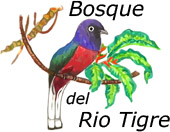Introduction to the Site List
This site list of 400 species is designed to give the visiting birder an idea of what birds can be found in our area. It includes all the species that have been seen (by us) around the lodge, the small nearby town of Dos Brazos and other areas up to 2 km from the lodge. Included as well are the species that have been seen on our regular birding excursions further afield, such as our famous morning trip to Rincón. The lodge is situated in lowland tropical forest at around 80 -110 meters above sea level.
Taxonomy: What’s in a Name?
All of the taxonomic divisions and names on the list are intended to be in agreement with the current AOU (American Onrnithologists’ Union) checklist, as of 2014. Your most important resource for birding in Costa Rica is “A Guide to the Birds of Costa Rica”, by Stiles and Skutch, published in 1989 and “The birds of Costa Rica” by Richard Garrigues and Robert Dean published in 2007. Given that more than a few years have gone by, some of the names you see here on this list will be different from those used in the field guides, an inevitable result of reclassification, renaming, etc. We have tried to include the old names as well (in parentheses) in an effort to minimize confusion.
A note on distribution
The list and abundance coding are certainly biased toward our little corner of the peninsula and the areas we regularly cover. Should you travel to another part of the peninsula, even just a few miles away, the species composition is likely to be quite different. Lucky for you, we seem to live in an area with exceptional diversity and species richness- perhaps you won’t want to go anywhere else!
Habitat: Variety is the spice of life
Each species on the list has been assigned one or more habitat codes, referring to where they are most often encountered. Some species like toucans and araçaris are very much generalists and can be found in a variety of habitats. Others such as the Uniform Crake, which is found almost exclusively in shady, wooded swamps, have a habitat preference that is more exact than we can express using a limited set of codes. This information can be found in your field guide! One key to a big list is to visit as many different habitat types as possible.
Occurrence: Here one day and gone the next
It is also worth bearing in mind that all species have some sort of patterns to their occurrence; nothing is static here. Besides the traditional north-south migration of temperate zone breeders, we observe many changes in the abundance of the “resident” birds as well. Many species, seemingly abundant in one part of the season, can become rather hard to turn up at other times. These changes, often quite abrupt, may be due to nesting, food availability, altitudinal migration, and other factors. The seasonal movements of many tropical species are still poorly understood and difficult to predict. Most notorious are frugivores such as cotingas, which may roam widely in search of fruiting trees. The erratic presence (or absence) of many hummingbirds is also notable.
Your keys to birding success
The most productive time of day for birding is early morning, when most species are both active and vocal. The sun rises fast in the tropics, and bird activity is usually greatly reduced after the first 3 hours of daylight. It is possible to bird all day here, but the early morning and late afternoon are certainly the most pleasant times.
Knowing vocalizations will prove invaluable if you plan to search for some of the more tricky species, especially the small forest flycatchers. You can spend days looking for spadebills, pygmy-tyrants, and bentbills without finding one, but as soon as you learn their calls you will find that they are not uncommon.
If you have certain species that you hope to see on your visit, especially those coded 4 or higher, please let us know! Low-density residents may be only represented by a few pairs; searching in the wrong place will prove fruitless.
And finally, please take advantage of our guiding. There is no substitute for local experience!
This new site list with habitat codes, commonality and Latin names was completed in 2006 (most recently updated July 2016) with the invaluable help of Scott Olmstead , an outstanding bird guide and naturalist, who we had the pleasure of working with during the 2005-2006 season. He is the sole author of the above introduction. There have been minor updates such as the total count and mention of the newly published field guide by Richard Garrigues and Robert Dean.
